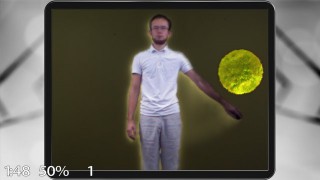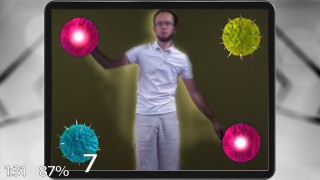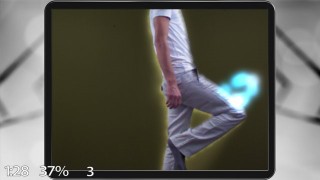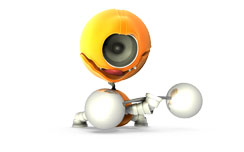
 |
 |
 |
BRIEF DESCRIPTION
In this game the patient’s task is to touch the virtual furry balls in the amount of time set by the therapist. The balls appear at random on the patient’s left and right. If the patient does not manage to touch a ball within the given time, the ball disappears and another ball appears in a random spot of the screen.
RECOMMENDATIONS AND POSSIBILITIES
The exercise improves the patient’s general spatial awareness and proprioception. The patient performs bilateral movements in response to the stimuli randomly appearing on her/his left or right. This exercise is recommended to patients with impaired concentration and inhibited response to stimuli. The module allows to practice and examine the patient’s dynamic reactions to randomly appearing moving and motionless objects, as well as it examines and improves the speed and effectiveness of decisions made by the patient in in response to positive and negative stimuli. The module is also a very good gauge of reaction-time and target-reaching time. It may be used to measure the differences in reaction- and the target-reaching times achieved by the left and the right hand.
PATIENT REQUIREMENTS
The patient can perform the exercise either sitting or standing. The exercise does not require any special abilities of the patient. The module is also appropriate for patients with limb amputations (in such cases it is not possible to compare reaction- and target-reaching times achieved by the right and left limbs; therefore the reports should be interpreted as concerning periodic changes in the patients’ results). In order to fully benefit from the exercise the patient needs to have unlimited range of motion.
TASKS
To reach towards the appearing objects as quickly as possible. To refrain from reaching (to restrain the movement) when the negative objects (balls with spines) appear.
DIFFICULTY LEVELS
The module has 4 levels of difficulty. Basically, the levels differ in the complexity of arrangement of the appearing objects. Besides that, on every of the levels the therapist can modify the amount of time for which an object is visible in the screen, the frequency of appearance of new objects, the amount of objects appearing on the left and on the right of the patient (for instance, to relieve the injured limb or to intensify the training). The therapist can also determine which part of the patient’s body is active during the exercise.
- Level 1: Single furry balls ( only positive stimuli) appear during the exercise. The patient’s task is to spike all of the appearing balls.
- Level2: Single furry or spiny balls (positive and negative stimuli) appear during the exercise. The patient has to spike the furry balls and refrain from touching the spiny balls – wait until a spiny ball disappears from the screen.
- Level3: Unlike on the two previous levels, the balls that appear on this level are in motion and move vertically on the right and left side of the screen.
- Level 4: 4 static balls appear in the screen at a time. Each set of 4 balls contains 2 furry (positive stimuli) and 2 spiny balls (negative stimuli). The patient has to avoid the spiny balls and spike only the furry balls as quickly as possible.
DATA AND REPORTS
The system saves data concerning and permits to analyze the level of correctness in performing the exercise, the level of the patient’s activity during the exercise, reaction-times measured independently for each part of the body, as well as the quality of actions taken in response to negative stimuli.
HINTS AND TIPS
The module offers various options of usage depending on the creativity of the therapist. For instance, it is possible to set the patient and the camera in the positions that allow to perform the exercise using feet instead of hands. Another option is to turn the patient sideways to the camera and to measure the times in which the patient reaches the targets located in front of and behind her/him.
More information


This is a modern approach to rehabilitation, which is fun for the patient. This form of a session, from the psychological point of view, brings many positive aspects, which result in stronger effects - desired in terms of improving the functioning of the people undergoing the rehabilitation. Find more Kinect Rehabilitation




